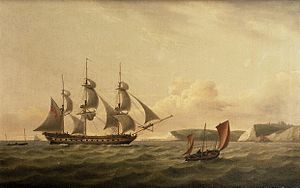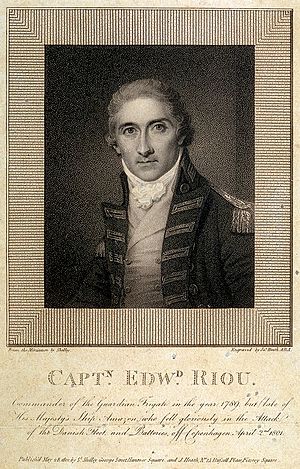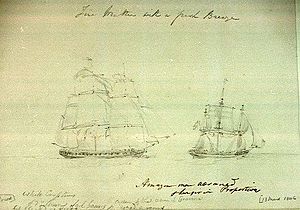HMS Amazon (1799) facts for kids

His Majesty's frigate Amazon, arriving off Dover, by Thomas Luny
|
|
Quick facts for kids History |
|
|---|---|
| Name | HMS Amazon |
| Ordered | 27 April 1796 |
| Builder | Woolwich Dockyard |
| Cost | £33,972 |
| Laid down | April 1796 |
| Launched | 18 May 1799 |
| Completed | 5 July 1799 |
| Commissioned | May 1799 |
| Fate | Broken up May 1817 |
| General characteristics | |
| Class and type | Fifth-rate Amazon-class frigate |
| Tons burthen | 1,038 6⁄94 (bm) |
| Length |
|
| Beam | 39 ft 5 in (12.0 m) |
| Draught |
|
| Depth of hold | 13 ft 9 in (4.19 m) |
| Propulsion | Sails |
| Sail plan | Full-rigged ship |
| Complement | 284 (later 300) |
| Armament |
|
HMS Amazon was a powerful warship called a frigate. She had 38 guns and was part of the Royal Navy (Britain's navy). Amazon sailed during the French Revolutionary and Napoleonic Wars. These were big conflicts between Britain and France.
The ship was commanded by famous naval leaders. One was Edward Riou, who led a group of frigates at the Battle of Copenhagen. After Riou was killed, John Quilliam took over. Quilliam later impressed Horatio Nelson, a very famous admiral. Nelson chose Quilliam to serve on his main ship, HMS Victory.
Amazon then served under William Parker. She continued to work with Nelson in the Mediterranean Sea. She also chased the French fleet to the West Indies during the Trafalgar Campaign. Later, Amazon joined Sir John Borlase Warren's fleet in the Atlantic. She helped defeat French forces in the action of 13 March 1806. During this battle, she captured the French frigate Belle Poule .
Amazon stayed in service for several more years. She fought against enemy raiders and privateers (private ships allowed to attack enemy ships). In 1811, she was taken out of active service. After the Napoleonic Wars ended, she was taken apart in 1817.
Contents
Amazon was a type of warship known as an 18-pounder fifth-rate frigate. This meant she carried 18-pounder cannons, which were quite powerful. She was one of two ships built to this specific design, the other being HMS Hussar.
The ship's plans were created by Sir William Rule. He was a top ship designer for the Royal Navy. Amazon was an improved version of his earlier frigate designs.
The ship was ordered on April 27, 1796. She was built at Woolwich Dockyard, a major shipbuilding center. Construction began in April 1796, and she was launched on May 18, 1799. This means she was put into the water for the first time.
Amazon was about 150 feet (45.7 m) long on her upper deck. She was 39 feet 5 inches (12.0 m) wide. The total cost to build her was about £33,972.
These ships were known for being "fast and very weatherly". This means they sailed well in different wind conditions. They could reach speeds of up to 13 knots (24.1 km/h). They were also very easy to steer.
Amazon had a crew of 284 sailors, which later grew to 300. Her main guns were twenty-eight 18-pounder cannons on the upper deck. She also had smaller 9-pounder guns and powerful carronades. Carronades were short-barreled cannons that fired heavy shot over short distances.
Adventures at Sea

Amazon began her service in May 1799. Her first captain was Edward Riou. In February 1800, Amazon and another ship, HMS Endymion, rescued a merchant ship called Trelawney. This ship had been captured by a French privateer named Bougainville. Amazon then captured Bougainville herself.
The next day, Bougainville crashed into Amazon and sank. Luckily, almost all of her crew were saved. Amazon also captured a French ship called Julie and rescued another merchant ship, Amelia.
The Battle of Copenhagen
In 1801, Captain Riou and Amazon joined a large British fleet. This fleet, led by Admiral Sir Hyde Parker and his second-in-command, Horatio Nelson, sailed to the Baltic. Their goal was to make Denmark leave a group of countries that were against Britain.
Riou worked closely with Nelson before the Battle of Copenhagen. Nelson chose Riou to lead the frigates and smaller ships. He told Riou to support the main fleet during the attack.
On April 2, as the battle started, some of Nelson's large warships got stuck on sandbanks. This forced the British to change their attack plan. Riou bravely led his frigates to attack the strong Danish Trekroner Fort and their blockships (old ships used to block a channel).
Even though the frigates were outmatched and in danger, they kept fighting for hours. The ships suffered many casualties. Captain Riou himself was hit in the head by a piece of wood from a cannonball impact.
Later, Admiral Parker, who was outside the harbor, signaled Nelson to pull back. Nelson famously ignored the signal. However, Riou, being a junior officer, had to obey the direct order. He gave the command for his small group of ships to retreat.
Turning away meant Riou's ships showed their backs to the Danish guns. This was their most vulnerable area. As other frigates pulled back, the smoke from the battle cleared. This left Amazon fully exposed to the Danish cannons.
A soldier on board, Lieutenant-Colonel William Stuart, described Riou's last moments. Riou was encouraging his men, even though he was wounded. He was sad to retreat and wondered what Nelson would think. His clerk was killed next to him. Then, a shot hit several marines. Riou then said, "Come, then, my boys, let us all die together!" Right after he said this, he was hit by a fatal shot.
Command of Amazon then went to her first officer, John Quilliam. He finished the retreat. After the battle, Nelson visited the damaged Amazon. He asked Quilliam how he was. Quilliam's calm reply, "Middlin'," amused Nelson. This may have led to Nelson later choosing Quilliam as his first officer on HMS Victory. After this, Captain Samuel Sutton took command of Amazon.
Serving with Nelson
In November, Captain William Parker became Amazon's new captain. Under Parker, Amazon captured a French privateer named Felix in July 1803. She also survived a close call with a French fleet in May 1804.
Amazon then joined Nelson's fleet in the Mediterranean in 1805. This was part of the Trafalgar Campaign. Nelson once asked Parker to bring live cattle to supply the fleet. Amazon was a very clean and well-kept ship, so this was an unusual request. Parker returned with 60 bullocks and 30 sheep! Nelson was very pleased with his good service.
Parker and Amazon stayed with Nelson. Nelson wanted to send secret instructions to his captains. He didn't want to stop the fleet to do this. So, he gave the plans to Parker. Parker, described as the 'best frigate captain in the service', quickly sailed Amazon along the line of ships. He delivered the instructions so fast that the fleet barely slowed down.
After returning to Europe, Amazon captured a Spanish privateer called Principe de la Paz in September 1805. This ship had 24 guns and a crew of 160. She had captured two British merchant ships.
Amazon was not at the famous Battle of Trafalgar in October 1805. The next year, she was in the Atlantic. She was part of a fleet chasing a French admiral. They unexpectedly met another French fleet. Amazon got involved in the battle on March 13, 1806. During this fight, she chased and captured the French 40-gun frigate Belle Poule. Amazon had four sailors killed and five wounded in this battle.
In August 1807, Amazon helped capture a Danish merchant ship called Speculation. In January 1810, she captured the French privateer Général Pérignon after a long chase. This ship had been very successful at attacking British trade.
Captain John Joyce briefly commanded Amazon in May 1810. But Parker returned in February 1811. He then captured another French privateer, Cupidon, in March of that year.
Final Years
In December 1811, Amazon was taken out of service and stored at Plymouth. She was officially "paid off" (meaning her crew was dismissed) the next year. She remained out of service for the rest of the Napoleonic Wars. Finally, Amazon was broken up (taken apart for materials) at Plymouth in May 1817.
Captured Ships
Here are some of the ships that Amazon or her crew helped capture or destroy:
Images for kids



